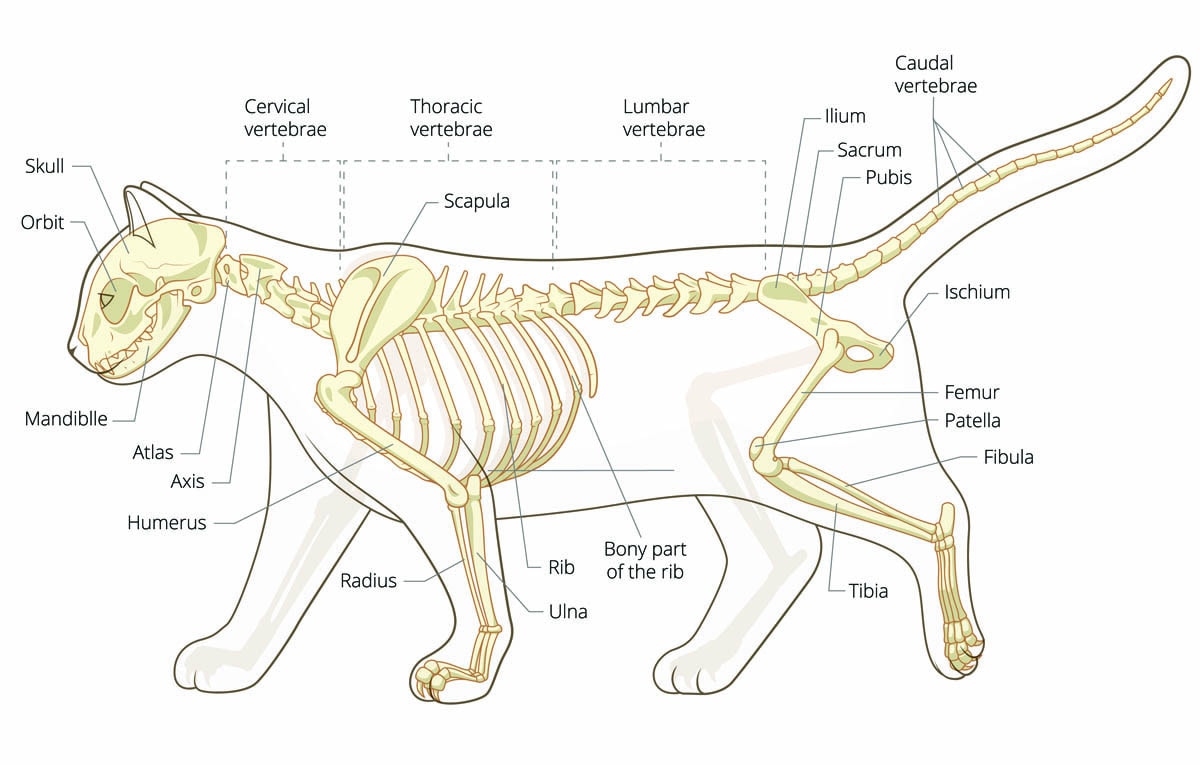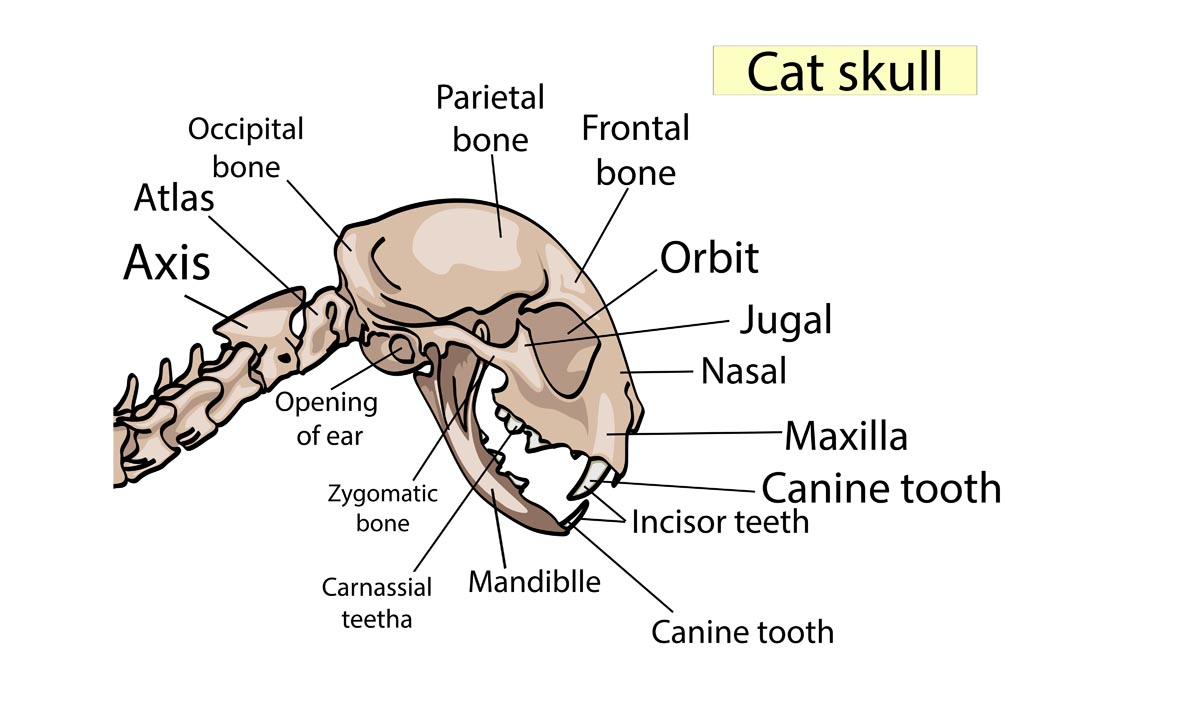How many bones does a cat have?
The average cat has between 240 – 245 in its body, this may vary a fraction as some cats have slightly more or fewer bones in their tail and, or additional toes (polydactyl). Male cats also have a bone in their penis.
Names of bones in the cat’s body

| Type of bone | Name | Number of bones |
| Head (skull, jaw, cheeks, eye sockets) | Mandible (lower jaw), premaxilla, maxilla, nasal, lacrimal (eye socket), zygomatic (cheek), frontal, zygomatic process, tympanic and squamosal (temporal), parietal, occipital | 29 |
| Neck (cervical) | Atlas (first bone), axis (second) then C3, C4, C5, C6, C7 | 7 |
| Back (thoracic) | T1 – T13 | 13 |
| Lumbar (lower back) | L1 – L7 | 7 |
| Sacral | Located between the hip bones | 3 |
| Tail (caudal) | C1-C23 | 20-23 |
| Ribs | 26 (13 each side) | |
| Shoulders | Scapula | 2 (1 each side) |
| Breastbone (sternum) | Manubrium, sternebrae, xiphoid process | 3 |
| Clavicle | 1 | |
| Pelvis | Ilium, ischium and the pubis | 6 (3 each side) |
| Forelimbs | Humerus (upper), ulna and radius (lower) | 6 (3 each side) |
| Hindlimbs | Femur (upper), tibia and fibula (lower) | 6 (3 each side) |
| Kneecaps | Patella | 2 (1 each hind leg) |
| Wrists (carpal) | Pisiform, unciform, cuneiform, scapho-lunaire, magnum, trapezoid, trapezium | 14 (7 each leg) |
| Heels/ankles (tarsal) | Calcaneum, astragalus, calcaneum, cuboid, cuneiform tertium, tuberosity, cuneiform secundum, cuneiform primum | 16 (8 each leg) |
| Feet (excluding toes) | Metacarpal (foreleg), metatarsal (hind leg) | 18 |
| Toes (phalanges) | 3 bones per toe. Distal, middle and proximal | 54 toes. 30 toes (2 front feet), 24 (2 hind feet) |
| Penis | Baculum | 1 |
| Throat | Hyoid | 1 |
| Ears (inner) | Malleus (hammer), incus (anvil), stapes (stirrup) | 6 (3 each ear) |
More about the cat’s skeleton
The skeleton is the internal framework of your cat’s body consisting of the bones, ligaments, and tendons. It can be broken up into sections known as axial, visceral and appendicular.
- The axial skeleton consists of the head, vertebrae, ribs, and sternum.
- The visceral skeleton contains the bones of the soft organs such as the inner ears, penis, throat.
- The appendicular skeleton consists of the bones of the legs and pelvis.
Furthermore, bones can are classified by their shape.
- Long bones – Found in the legs and feet their role is to support the weight, allow large movement. These bones are longer than they are wide.
- Flat bones – Located in some parts of the skull, the sternum, shoulders, ribs and the pelvis, these bones protect the internal organs.
- Short bones – Found in the wrists (carpals) and ankles (tarsals). They provide stability and fine movement.
- Irregular bones – Found in the vertebrae and some parts of the skull.
What do the bones do?
- Support and stability – They are the framework of the cat’s body.
- Protect – The bones surround the delicate and vital organs such as the brain, heart, lungs, kidneys etc.
- Blood cell production – The bone marrow inside the bone produces all of the blood cells.
- Movement – Muscles are attached to the bones by the tendons.
- Storage – Calcium and phosphorous, which is released when needed.
Certain bones may also provide additional functions such as the tail which is used for balance and communication, the ear bones to assist with hearing and the penis bone, which helps the male keep a prolonged erection.
Head – There are 29 bones in the cat’s head. The feline head can be loosely broken into the skull, face (eyes, nose, cheeks) and jaw. The thick skull bone protects the cat’s delicate brain; other bones include the jawbones (mandible and maxilla), nasal bones, cheekbones and eye orbit.

Neck and spine (vertebrae): These bones run along the upper part of the cat’s body from the skull to the tail. There are 7 neck bones, 13 backbone, 3 sacral bones and 20-23 tail bones. The cat’s vertebrae are not as tightly connected as that of the human, with much greater elasticity in the disks between the bones, making it much more flexible.
Ribs: The ribs surround the chest cavity on either side; there are 13 pairs of rib bones in the cat.
Shoulders (scapula): The scapula is not attached to other bones; it is held in place by muscles.
Pelvis: The pelvis is divided into two halves, each containing three bones, the ilium, ischium, and the pubis.
Sternum and clavicle: Also known as the chest bone, the sternum is a flat bone in the chest protecting the heart and lungs, the ribs connect to the sternum via cartilage. The clavicle attaches to the sternum and shoulder blades in humans; however, in cats, this tiny bone is located deep within the chest muscle. This makes the cat’s chest much narrower and deeper than other mammals, increasing the length of his stride and allowing him to squeeze into narrow places.
Legs: The bones of the legs are long bones. The long bones of the foreleg consist of the humerus in the upper leg, and the lower leg has the ulna and radius bones. The toes follow the carpal (wrist) bones. The cat’s hind leg consists of the femur (upper leg), and the tibia and fibula below consists and the cat’s rear foot connects the tibia and fibula to the tarsal bones, a group of seven bones
Wrists and /ankles/heels: Connecting the legs to the feet on the foreleg are the carpal (front legs) and tarsal (rear legs) bones.
Feet (excluding toes): Cats have metacarpals in their front legs and metatarsals in their hind legs. Each front foot has five metacarpal bones, and each hind foot has four metatarsal bones.
Toes: Cats have five toes (phalanges) on the front (foreleg), one of these toes is the dewclaw which sits higher up on the foot and does not come into contact with the ground. There are four toes on the rear (hind leg). Each cat toe has three bones, the distal, middle and proximal phalange. The cat’s claw is attached to the distal phalange. Cats are digitigrade, which means walk on their toe (unlike humans who walk on the flat of the foot). When a cat is declawed, the claw along with the distal phalange is amputated. Some cats have additional toes, known as polydactyly (or Hemingway cats). Certain breeds are more prone to this including Maine Coons and Bobcats.
Tail: The final section of the vertebrae, the cat’s tail consists of between 20 and 23 bones.
Throat: The throat contains an unusual bone called the hyoid. Its principal function is to anchor the tongue; it is also believed that it helps lions produce their characteristic roar and in domestic cats, their purr.
Penis: The male cat has a small bone in the penis (as do many mammals), this allows the penis to remain hard during copulation, meaning he can do so for extended periods.
Inner ears: Known as ossicles, these tiny bones of the inner ear help to amplify sound.
Disorders of the bones
- Cancer: Cancer is the unchecked growth of certain cells within the body. It may be primary or secondary. Primary cancer is the original site, and secondary cancer is where cancer has spread from its primary location to another part of the body (known as metastasis). There are several types of cancer to affect the bones, which include osteosarcoma, fibrosarcoma, and chondrosarcoma.
- Broken bones: The most common breakages cats suffer are a broken jaw, pelvis, and legs.
- Polydactyly: Some cats are born with additional toes caused by a dominant gene. In most cases, this causes no problems for affected cats.
- Vitamin A toxicity: This can result in excess bone growth (known as exostosis), especially in adult cats.
- Osteodystrophy: This is a genetic condition that affects Scottish Fold cats. Bony growths form on the spine and the feet.
- Bone infections (osteomyelitis): Bacteria are the most prevalent organism involved, although fungal infections can also occur. Infections can invade the bone (which is porous) or enter via an injury.
- Rickets: Due to a lack of vitamin D in the diet. Young cats are most often affected, with a bending of the long bones.

